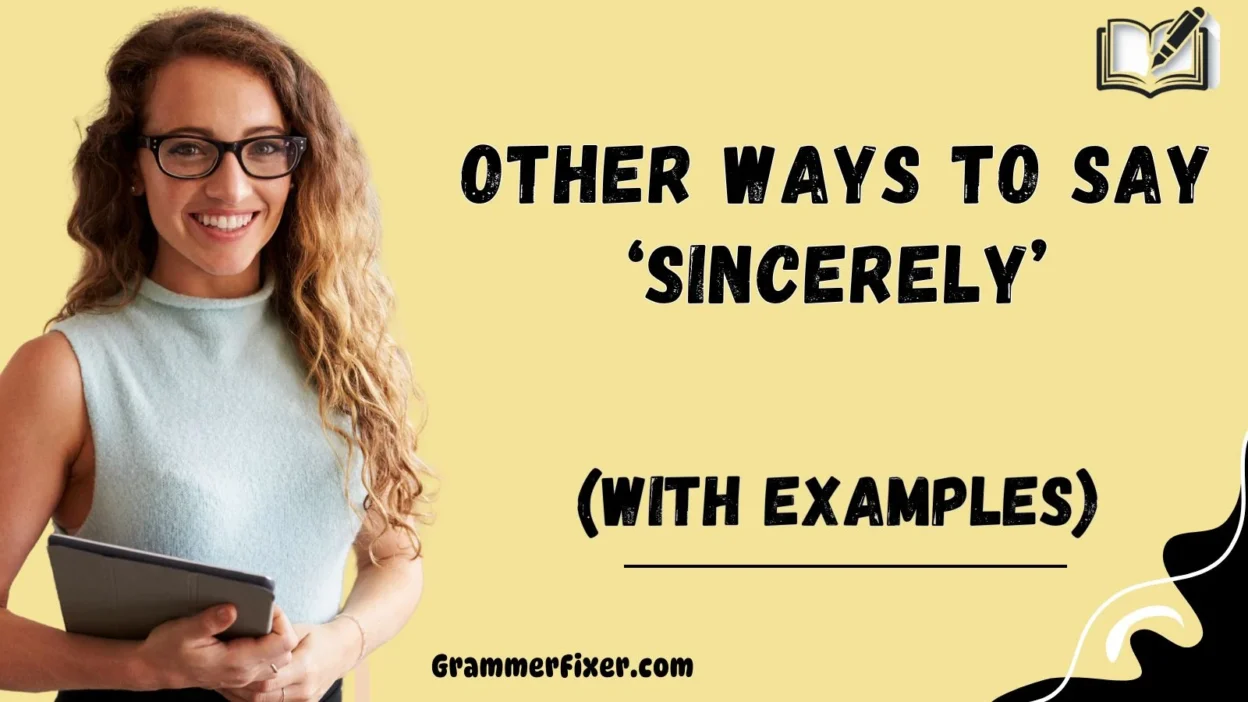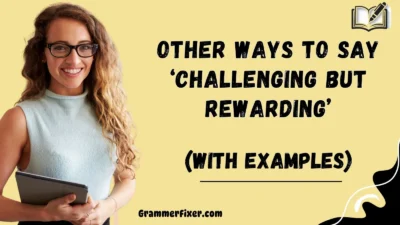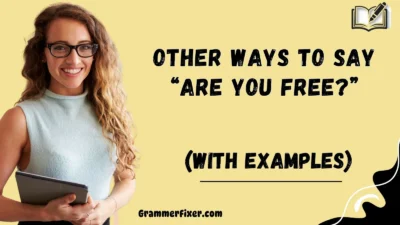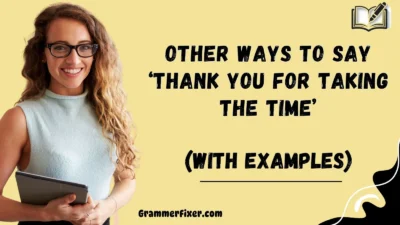Finding the right words to end an email or letter can make all the difference. “Sincerely” is timeless and professional, but sometimes it can feel a bit formal or impersonal. Choosing an alternative can help you express your tone — whether you want to sound warm, appreciative, confident, or approachable.
Below are 30 professional alternatives to “Sincerely” that will help your message feel more personal, polished, and thoughtful.
What Does “Sincerely” Mean?
“Sincerely” means genuinely, honestly, or truthfully. In writing, it signals that the message was sent with good intentions and honesty. It’s traditionally used to close letters and professional emails, expressing respect and authenticity toward the recipient.
When to Use “Sincerely”?
You can use “Sincerely” in formal emails, cover letters, or any correspondence where professionalism and respect are key. It works best when writing to clients, employers, business partners, or someone you haven’t built a personal rapport with yet.
Is It Professional/Polite to Say “Sincerely”?
Absolutely. “Sincerely” is one of the most professional and polite ways to end an email or letter. It’s safe, formal, and widely accepted in both business and academic communication. However, if you want to add a more personal or emotional touch, other alternatives might feel warmer or more modern.
Pros and Cons of Saying “Sincerely”
Pros:
- Universally understood and accepted
- Conveys honesty and respect
- Works in almost any formal setting
Cons:
- Can sound generic or old-fashioned
- Lacks warmth or personality
- Doesn’t always fit informal or creative industries
1. Best Regards
Meaning: A polite and professional way to express respect and goodwill.
Detailed Explanation: “Best Regards” is one of the most common alternatives to “Sincerely.” It feels respectful but slightly less stiff, making it suitable for modern workplaces.
Scenario Examples:
- Best Regards,
Michael Adams
Best Use: When communicating with clients, colleagues, or managers in a professional yet friendly tone.
Worst Use: In extremely formal letters (like government or legal correspondence).
Why It Works: It blends professionalism with approachability.
Tone: Polite, warm, and balanced.
2. Kind Regards
Meaning: A courteous and thoughtful sign-off showing kindness and respect.
Detailed Explanation: “Kind Regards” softens your message and conveys a touch of empathy, making it ideal for client relationships.
Scenario Examples:
- Kind Regards,
Emily Clarke
Best Use: Client correspondence, customer support, or follow-up messages.
Worst Use: Very casual emails or quick replies.
Why It Works: It feels warm without being overly familiar.
Tone: Courteous and sincere.
3. Warm Regards
Meaning: A warmer, more personal version of “Best Regards.”
Detailed Explanation: Adds a gentle emotional warmth, showing that you value the relationship.
Scenario Examples:
- Warm Regards,
Sophie Lee
Best Use: When writing to long-term clients or colleagues you know well.
Worst Use: In strictly formal business correspondence.
Why It Works: It bridges professionalism with personal sincerity.
Tone: Friendly and appreciative.
4. Respectfully
Meaning: Expresses respect and formality toward the recipient.
Detailed Explanation: Commonly used in official communication, especially when writing to someone of higher authority.
Scenario Examples:
- Respectfully,
David Green
Best Use: Writing to executives, professors, or government officials.
Worst Use: In informal or casual internal emails.
Why It Works: Demonstrates humility and deference.
Tone: Formal, respectful, and courteous.
5. Yours Truly
Meaning: A classic and heartfelt way to show sincerity.
Detailed Explanation: Slightly old-fashioned but still effective in certain contexts like cover letters.
Scenario Examples:
- Yours Truly,
Helen Carter
Best Use: Cover letters or formal thank-you notes.
Worst Use: Fast-paced business emails.
Why It Works: Evokes authenticity and earnestness.
Tone: Traditional and sincere.
6. With Appreciation
Meaning: A gracious way to close when you want to express gratitude.
Detailed Explanation: Perfect when you want to show genuine thanks in a professional tone.
Scenario Examples:
- With Appreciation,
Karen Brooks
Best Use: Thank-you emails, client updates, or acknowledgments.
Worst Use: Routine messages with no emotional context.
Why It Works: Adds heartfelt gratitude to your message.
Tone: Appreciative and warm.
7. With Gratitude
Meaning: A simple yet powerful way to end with thankfulness.
Detailed Explanation: Slightly more formal than “Thanks,” but much more genuine and heartfelt.
Scenario Examples:
- With Gratitude,
Daniel Cooper
Best Use: After receiving help, feedback, or an opportunity.
Worst Use: In purely transactional emails.
Why It Works: It personalizes your appreciation.
Tone: Grateful and heartfelt.
8. Warmly
Meaning: A short, friendly sign-off showing warmth and approachability.
Detailed Explanation: Ideal for professional relationships that have a personal rapport.
Scenario Examples:
- Warmly,
Nina Patel
Best Use: Messages to clients or colleagues you know well.
Worst Use: Cold emails or job applications.
Why It Works: Adds a human touch without losing professionalism.
Tone: Friendly and genuine.
9. Cordially
Meaning: Polite, formal, and slightly traditional.
Detailed Explanation: Works well in invitations or messages requiring courtesy.
Scenario Examples:
- Cordially,
Thomas Gray
Best Use: Invitations, announcements, and professional correspondence.
Worst Use: Fast, informal internal chats.
Why It Works: Conveys respect and politeness.
Tone: Formal and courteous.
10. Faithfully
Meaning: Commonly used in British English after formal letters.
Detailed Explanation: It means “with loyalty” or “with true regard.”
Scenario Examples:
- Yours Faithfully,
Edward Stone
Best Use: Formal letters where the recipient’s name is unknown.
Worst Use: U.S.-based business emails.
Why It Works: Retains classic professionalism.
Tone: Formal and traditional.
11. All the Best
Meaning: A casual, upbeat, and positive way to close.
Detailed Explanation: It conveys goodwill and optimism, ideal for friendly professional exchanges.
Scenario Examples:
- All the Best,
Olivia Grant
Best Use: Emails with colleagues or friendly clients.
Worst Use: Formal proposals or legal communication.
Why It Works: It ends your message on a warm and encouraging note.
Tone: Friendly and optimistic.
12. Many Thanks
Meaning: A polite and grateful closing.
Detailed Explanation: Simple yet effective, expressing genuine appreciation.
Scenario Examples:
- Many Thanks,
Ben Harris
Best Use: When someone helped you or responded to a request.
Worst Use: Formal job applications.
Why It Works: Shows humility and gratitude.
Tone: Appreciative and kind.
13. Yours Respectfully
Meaning: A deeply courteous sign-off expressing esteem.
Detailed Explanation: Suitable for letters requiring high formality.
Scenario Examples:
- Yours Respectfully,
Jonathan Wells
Best Use: Formal letters or communication with senior officials.
Worst Use: Casual workplace messages.
Why It Works: Emphasizes politeness and deference.
Tone: Formal and serious.
14. Best Wishes
Meaning: A warm and positive closing that conveys goodwill.
Detailed Explanation: Often used when you want to end on a supportive tone.
Scenario Examples:
- Best Wishes,
Hannah Kim
Best Use: Congratulatory or friendly messages.
Worst Use: Legal or business proposals.
Why It Works: Adds humanity and empathy to your email.
Tone: Friendly and encouraging.
15. Cheers
Meaning: A friendly, informal, and modern closing.
Detailed Explanation: Common in British and Australian English; conveys friendliness and gratitude.
Scenario Examples:
- Cheers,
Jake Morgan
Best Use: Informal professional relationships.
Worst Use: Formal or serious correspondence.
Why It Works: Sounds conversational and relaxed.
Tone: Informal and friendly.
16. With Respect
Meaning: A formal closing that conveys admiration or professional courtesy.
Detailed Explanation: “With Respect” is best used in communication that requires acknowledgment of the recipient’s authority or expertise.
Scenario Examples:
- With Respect,
Laura Bennett
Best Use: Letters to superiors, mentors, or officials.
Worst Use: Everyday workplace emails.
Why It Works: It reflects professionalism and thoughtful regard.
Tone: Formal, respectful, and courteous.
17. Yours Cordially
Meaning: A refined and polished alternative to “Cordially.”
Detailed Explanation: It combines warmth with professionalism, making it perfect for polite correspondence.
Scenario Examples:
- Yours Cordially,
Victor Hayes
Best Use: Professional letters, event invitations, or partnership requests.
Worst Use: Casual emails or quick follow-ups.
Why It Works: Adds a sophisticated yet gentle close to your message.
Tone: Polite and elegant.
18. With Warmest Regards
Meaning: A more affectionate variation of “Warm Regards.”
Detailed Explanation: Ideal for clients or colleagues you’ve built a strong relationship with.
Scenario Examples:
- With Warmest Regards,
Melissa Young
Best Use: Long-term relationships, thank-you messages, or partnership anniversaries.
Worst Use: Initial cold outreach emails.
Why It Works: Balances emotion and professionalism beautifully.
Tone: Warm and appreciative.
19. Yours in Service
Meaning: Indicates commitment and humility in professional or community-oriented communication.
Detailed Explanation: Often used by those in service-oriented professions such as education, healthcare, or public service.
Scenario Examples:
- Yours in Service,
Dr. Alan Rivera
Best Use: Nonprofit, educational, or humanitarian correspondence.
Worst Use: Corporate or sales-focused communication.
Why It Works: Shows dedication and sincerity of purpose.
Tone: Humble and service-minded.
20. With My Compliments
Meaning: A refined, elegant way to express goodwill and acknowledgment.
Detailed Explanation: Common in formal business letters and communications involving gestures of respect or gifts.
Scenario Examples:
- With My Compliments,
Charlotte James
Best Use: Professional gestures, introductions, or thank-you notes.
Worst Use: Routine office communication.
Why It Works: Adds a touch of refinement and respect.
Tone: Formal and polished.
21. Yours Faithfully and Truly
Meaning: A hybrid of traditional phrases emphasizing sincerity and loyalty.
Detailed Explanation: It feels deeply genuine and works in contexts where you want to sound earnest and respectful.
Scenario Examples:
- Yours Faithfully and Truly,
Matthew Cole
Best Use: Personal yet formal letters or heartfelt business correspondence.
Worst Use: Modern or fast-paced corporate communication.
Why It Works: Combines emotional honesty with professional tone.
Tone: Heartfelt and formal.
22. With Sincere Thanks
Meaning: A direct yet gracious expression of appreciation.
Detailed Explanation: A variation that keeps the root meaning of “Sincerely” but adds warmth through gratitude.
Scenario Examples:
- With Sincere Thanks,
Alicia Reed
Best Use: After receiving help, advice, or an opportunity.
Worst Use: Messages that don’t involve gratitude.
Why It Works: Feels natural and authentically thankful.
Tone: Appreciative and genuine.
23. Yours Thankfully
Meaning: A formal and traditional closing focused on appreciation.
Detailed Explanation: Common in older British correspondence but still effective in formal thank-you letters.
Scenario Examples:
- Yours Thankfully,
James Porter
Best Use: When expressing gratitude in a formal tone.
Worst Use: Informal workplace conversations.
Why It Works: Carries a respectful and thankful sentiment.
Tone: Formal and courteous.
24. In Appreciation
Meaning: Communicates acknowledgment and gratitude for someone’s efforts.
Detailed Explanation: Useful when the entire message centers around recognizing someone’s contribution.
Scenario Examples:
- In Appreciation,
Rachel Adams
Best Use: Employee appreciation messages or client recognition.
Worst Use: Transactional business correspondence.
Why It Works: Highlights gratitude in a simple, clean way.
Tone: Appreciative and positive.
25. Take Care
Meaning: A casual but caring way to close an email.
Detailed Explanation: Adds a gentle personal touch, especially after friendly exchanges.
Scenario Examples:
- Take Care,
Olivia Perez
Best Use: When writing to a colleague or client you have a friendly rapport with.
Worst Use: Formal or first-contact emails.
Why It Works: Makes your tone feel kind and personal.
Tone: Friendly and warm.
26. With Kindest Regards
Meaning: A more heartfelt form of “Kind Regards.”
Detailed Explanation: Suitable when you want to emphasize warmth, empathy, or gratitude in your tone.
Scenario Examples:
- With Kindest Regards,
Henry Dawson
Best Use: Thank-you or farewell emails.
Worst Use: Formal corporate messages or applications.
Why It Works: Enhances connection and sincerity.
Tone: Warm, thoughtful, and caring.
27. With Respect and Gratitude
Meaning: A combined expression of appreciation and admiration.
Detailed Explanation: Perfect when thanking mentors, leaders, or respected colleagues.
Scenario Examples:
- With Respect and Gratitude,
Sophia Brown
Best Use: Professional thank-you letters or awards communication.
Worst Use: Simple day-to-day work updates.
Why It Works: Shows maturity and emotional intelligence.
Tone: Gracious and formal.
28. Appreciatively
Meaning: A concise and polished word showing acknowledgment and gratitude.
Detailed Explanation: A single-word closing that feels formal yet heartfelt.
Scenario Examples:
- Appreciatively,
Ethan Rogers
Best Use: Professional messages where you want to sound thankful but direct.
Worst Use: Cold or impersonal communications.
Why It Works: Compact yet emotionally resonant.
Tone: Polished and grateful.
29. Ever Yours
Meaning: A poetic and timeless way to show loyalty or connection.
Detailed Explanation: Though slightly romantic in tone, it can suit creative or personal professional exchanges.
Scenario Examples:
- Ever Yours,
Isabella Reed
Best Use: Personal notes or messages in creative industries.
Worst Use: Corporate or executive communication.
Why It Works: Expresses heartfelt sincerity.
Tone: Emotional and classic.
30. With Professional Regards
Meaning: A strong, polished closing for business correspondence.
Detailed Explanation: Ideal when you want to maintain professionalism without sounding distant.
Scenario Examples:
- With Professional Regards,
Andrew Lewis
Best Use: Business emails, partnership communications, or client reports.
Worst Use: Personal or casual exchanges.
Why It Works: Balances formality with courtesy.
Tone: Professional and respectful.
Conclusion
Choosing the right closing isn’t just about formality — it’s about how you want the other person to feel when they finish reading your message. Whether you use “Best Regards” to sound approachable, “With Appreciation” to show gratitude, or “Respectfully” to convey deference, your choice shapes the tone of your communication.
In a professional world that values both clarity and warmth, replacing “Sincerely” with a thoughtful alternative can make your message stand out as genuine, intentional, and human.



